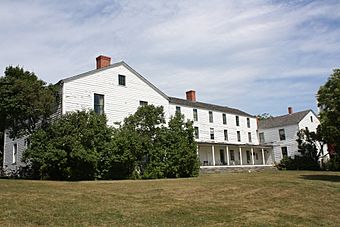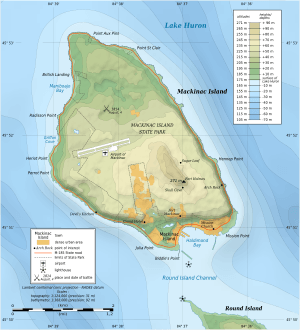Mission House (Mackinac Island) facts for kids
Quick facts for kids |
|
|
Mission House
|
|

Mission House in 2011
|
|
| Location | Huron St, Mackinac Island, Michigan |
|---|---|
| Area | 1 acre (0.40 ha) |
| Built | 1825 |
| Built by | Martin Heydenburk |
| NRHP reference No. | 71000410 |
| Added to NRHP | April 16, 1971 |
The Mission House is a very old and important building on Mackinac Island in Michigan. It was built way back in 1825. Today, it is owned by the state of Michigan and is part of the Mackinac Island State Park. This historic building is listed on the National Register of Historic Places, which means it's recognized as a special place in American history.
Contents
What is the Mission House?
The Mission House is made of wood and has a special U-shape. The middle part of the building is three stories tall. The two parts on the sides, called wings, are two stories tall. At the front, there's a porch that covers the main entrance. This building has looked mostly the same since it was first built.
How the Mission House Was Built
In 1823, a missionary named William Montague Ferry and his wife, Amanda, started a mission on Mackinac Island. They chose a spot now known as Mission Point. Two years later, in 1825, the Mission House was built there. A teacher and carpenter named Martin Heydenburk led the building team.
The Mission House was a big part of a plan by the American Board of Commissioners for Foreign Missions. This group wanted to share Christianity with Native American people living around the Great Lakes. The building also reminds us of the important fur trade era in Great Lakes history.
A School and Home for Students
The Mission House was designed to be both a school and a place for students to live. Students came from Native American, Métis, and European-American families. They lived at the school and learned useful skills like crafts. They also studied basic subjects like reading and writing. The goal was to teach them ways of living similar to those in New England. In 1827, 112 students were enrolled here.
The building was simple and practical, made for its purpose as a school and dormitory. The wood used to build it came from a nearby place called Mill Creek.
The Mission House was the biggest building in a group of buildings. This group also included the Mission Church, built a few years later, and fields where students learned about farming. The Ferry family, who started the mission, lived in the Mission House for 12 years. Their son, Thomas W. Ferry, who later became a U.S. Senator, was born in this house in 1827.
From School to Hotel
The mission on Mackinac Island struggled to support itself financially. Also, the fur trade in the Great Lakes started to decline in the late 1830s. In 1837, Michigan became a state, and the Ferry family moved away. The mission buildings were then left empty.
As the fur trade ended, more settlers moved into Michigan. For many years, Mackinac Island was a busy stop for steamboats on the Great Lakes. Many people traveling to Lake Michigan would change boats at Mackinac Island. They needed places to stay during their stopovers.
In 1849, a man named Edward Franks bought the unused Mission House. He added a third story to the building, which had only two stories before. He then opened it as a hotel and boarding house, keeping the name "Mission House."
After the Civil War, more people started traveling for fun in northern Michigan. The Mission House became a simple vacation spot. However, as the 1900s began, the old building was not as comfortable for travelers anymore. The Great Depression in the 1930s made things even harder. The hotel, still run by the Franks family, closed in 1939.
New Uses for the Historic Building
After being empty again, the Mission House found a new purpose in 1946. It became a temporary home for a group called the Moral Re-Armament (MRA) movement. This group, led by Rev. Frank Buchman, made Mackinac Island their main base. They built a large conference center next to the old dormitory.
In 1965, MRA decided to turn their center on Mackinac Island into a college. However, the college was not very successful and closed in 1970. The next year, MRA stopped its activities on Mackinac Island and sold its properties.
Later, in 1977, a company bought the property and turned it into the "Mackinac Hotel and Conference Center." People worried that the historic 1825 Mission House might not last much longer. So, the Mackinac Island State Park Commission bought it. They restored the building and changed its inside into living spaces for the park's seasonal workers. The inside of the Mission House is not open to the public today.
The Mission House in Stories
In 1863, a writer named Edward Everett Hale wrote a famous story called The Man Without a Country. The story begins with a sentence about the Mission House: "I was stranded at the old Mission House in Mackinaw, waiting for a Lake Superior steamer which did not choose to come."
It's interesting because Edward Everett Hale never actually visited Mackinac Island or Michigan himself. He was able to write about places he hadn't seen because he had many books and publications available to him. Hale was a writer, editor, and minister who lived and traveled mostly in New England.
A Registered Historic Site
The Mission House was officially listed on the National Registry of Historic Sites in 1971. It was also added to the Michigan Registry of Historic Sites in 1993. It is known as Michigan Historic Site #SO313. A special marker has been put up to show its importance.




